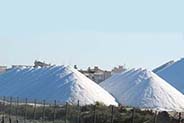Torrevieja is located about 50 km south of the city of Alicante and has a population of 105,720 (the number is from 2012). Torrevieja was originally a salt-extraction and fishing village, located between the sea and two large salt lakes (Las Salinas). These are the ones that give Torrevieja a healthy microclimate.
Until 1802, Torrevieja existed only as an old watch tower and some working cabins. It was the old watch tower that gave the city its name: Torre Vieja (Spanish) means Old Tower. But in 1803, Karl IV allowed permission to move the salt production office from La Mata to the city itself and also allowed houses to be built there.
In 1931, Alfonso XIII gave Torrevieja the status as a city. During that period there was also a growing market for flax, hemp and cotton from the area.
In the 19th century, the salt was mainly shipped from the city on Swedish and Dutch ships. At that time, there was only very limited demand for salt from other regions of Spain, primarily Galicia and, to a lesser extent, Valencia. Even at the dawn of the 20th century, a quarter of all salt extracted from the lagoon in Torrevieja was sold in Spain itself, the rest was exported to foreign markets. Today salt extraction is still an important industry in Torrevieja and a very large employer.
However, Torrevieja has evolved into becoming a more and more popular tourist city. The construction industry is developing dramatically, today there is sold a huge amount of homes for especially sun hungry northern Europeans. It’s no wonder that the area has become very popular, the mild winters and hot summers as well as the fact that the area is proclaimed by the WHO as one of the 3 healthiest places to live in the world has meant that popularity is growing.
If you have any comments about this article, please contact the administrator at kv@dktilspanien.dk

